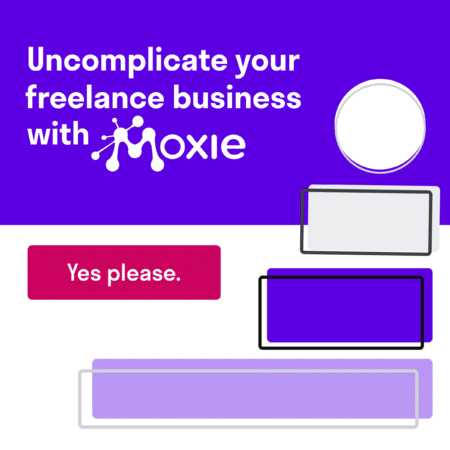Design is an industry particularly well-suited to freelancing. The discipline encompasses many niches — from graphic design to illustration, UX/UI to architecture — and the work can typically be done from anywhere, especially since the pandemic accelerated remote-work practices worldwide.
For independent designers — particularly recent design graduates looking to establish their career as freelancers — getting clients is the most important and monumental first task. Read on for essential tips and tricks you can use as a designer to get more clients.

All Designers Need a Website
If you are serious about getting clients as a freelance designer, you simply have to have your own website with an engaging portfolio and strong SEO practices.
Yes, social media networks like Dribble, Behance, and Instagram are important for marketing your design skills to potential clients, but those networks alone are not enough to establish you as a credible design professional.
Instead of hosting your graphic design, UX/UI design, or illustration portfolio on someone else’s platform, claim your own piece of online real estate. With your own site, you have complete control to optimize your SEO and attract new clients to your freelance design practice.
The .com Days are Over
Your domain name is the first thing that every prospective client sees. In the Web 1.0 past, having a .com domain name was the only option if you wanted to be taken seriously.
Fast forward to today, and .com is so oversaturated, it’s no longer cool or interesting. Plus, it’s almost impossible to find a short, memorable, and meaningful .com domain name without spending hundreds or thousands of dollars in reseller markets.
Register a Free .design Domain Name for your Portfolio
The best option for designers today is to register a .design domain name. It works just like any other top-level domain, but it directly reflects what you do as a designer. Other web-hosting solutions providers include FlyWheel, WPEngine and DreamHost.
The .design top-level domain has quickly become an authoritative domain for the design industry. In addition to the thousands of freelance designers and design agencies using .design domain names, major brands like Spotify, Amazon, Slack, Adobe, Dropbox, Indeed, and Mozilla are using them for content marketing, recruiting, and for distributing design resources.
Build Your Brand on .design
When you build your brand and online presence around a .design domain name, your future customers will instantly understand what you do, even before arriving at your website.
Instead of settling for a long and clunky domain name like JaneSmithTheGraphicDesigner.com, opt for a simple, intuitive, and brandable alternative: JaneSmith.design. Short, memorable, and far easier to type, a .design domain looks innovative and unique on business cards, resumes, and even as your email address.
From an SEO perspective, a .design domain name is ideal because it includes the primary “design” keyword. With the “design” keyword built into the fundamental fabric of your website, you can focus your SEO strategies on more sophisticated techniques.

Web Design Brings Clients to You
Now that you have registered your domain, it’s time to build your site! As you build, set yourself up for success by employing web design best practices.
Your navigation, titles, meta descriptions, and even the URLs themselves are important clues for readers and bots alike. If these crucial elements are logical and organized, then your content will gain traction.
Mobile First
As a designer, you’re more likely than most to work on a large, high-resolution monitor. But remember that most of the world accesses the internet through a myriad of different mobile devices.
To make sure that your website is accessible and legible to as many people as possible, you need to optimize for mobile. Responsive mobile versions of sites are so important that they get indexed too! Google’s mobile-friendly testing tool is a great resource to ensure that your site is just as effective on an iPhone, Android, or iPad as it is on your big fancy monitor.
With mobile-first design, loading speed is an important concern. While designers are acutely aware of image quality, and would probably prefer big, beautiful, high-resolution image files, the hard truth is that your search ranking will get dinged if your site takes too long to load. Make sure that your images are sized and scaled appropriately.
Intuitive Navigation
Your .design website should be intuitive and easy to navigate. Ideally, it should take three clicks or less to get from any page of your site to any other page. If you have to click through too many pages to access important content, then you probably need to restructure your website to make it more accessible. (Keep it simple!)
Every URL in your website should be short and meaningful. Use real words, not random numbers. Use a dash (-) to separate individual words — this improves legibility.
Homepage Does Heavy Lifting
A huge amount of your site traffic — about 40% — will go straight to your homepage. It’s the portal that welcomes everyone to your digital doorstep, so you want it to shine!

With so much traffic coming though your homepage, it’s important to continuously update the content there. Whether with new images, offers, or client reviews, fresh content on the homepage is always a good investment of your time.
SEO With Content Marketing
Once you’ve registered your .design domain name and developed the foundation for your website, it’s time to add content!
Show Off Your Digital Portfolio
Your first priority should be your portfolio.
If you’re just starting out in the design industry, you might not have much actual client work to show. Don’t let this stop you from showcasing your talents right now. Designed a logo for a friend? Working on a personal passion project? Feature those too! Use whatever you have to get started, and continuously update your portfolio as you complete more work.
You can also strengthen your design skills and generate portfolio content by working on mock creative briefs. Put yourself in a clients’ shoes, imagine your dream project, and turn it into reality.
If you need some inspiration to help you generate projects relevant to your design niche, check out the Goodbrief creative brief generator featured on Rooki.design. You can narrow the type of work with categories like logo design, brand identity, website building, packaging, illustration, and more. And you can choose industries like fashion, retail, food, travel, and several others.
Create Targeted Blog Posts
So you’ve got your portfolio online. Everyone who visits will see how talented you are. Now… how do you get those visitors to click on your site?
Blog posts are a great way to bring traffic to your site. Keeping your site frequently updated helps you rank higher in search results, and demonstrating your familiarity with new developments in your industry will build your brand and your authority as a designer.

To find inspiration for your blog posts, put yourself in your prospective clients’ shoes once again. What problems are they facing? How do your skills help solve them?
If you structure your blog posts around a problem that people need help solving, you’ll have better SEO results. For example, a search query like “How to make product packaging stand out” will have less competition than an extremely broad query like “packaging design.”
Think in terms of conversational phrases that someone would actually use, and write in a way that addresses those questions and answers them. This strategy means you’re really thinking about your future clients’ intent, rather than just focusing on keywords. The content you create will be all the better for it.
Optimize SEO on Every Page
Whether it’s a blog post or a portfolio piece, every page on your website needs effective SEO.
Be sure to include meta descriptions for every page. Keep the description short and conversational. Use keywords organically — don’t overstuff your description with keyword spam.
Formatting text doesn’t just make it look pretty and easier to read — it also helps Google’s crawlers understand the relevance of your content.
The H1 tag is your top-level header. It should be used only once per page and should include your major keywords.
The H2 and H3 tags are subheaders that should include your more targeted and specific keywords. They should help both bots and readers follow the flow of your content and understand it more quickly.
You should also always use ALT tags on images. These are specifically intended to help make the internet accessible for people with visual impairments, but search engines also use them to help index the site. That means they offer two benefits in one!
Remember The Call-To-Action
“Always be closing.” On every page, make sure you include a call-to-action.
Your call-to-action should reiterate your services and encourage your site visitors to make contact with you. Offer a quote, a consultation, more information, or anything else of value that will entice your prospective customer to become an actual customer.
Make sure it’s easy for people to contact you: include an email form to capture email addresses and phone numbers so that you can follow up with them. The less work for your visitors, the better.
Promote Your Content
Once you’ve populated your site with beautifully composed and search-optimized content, you shouldn’t just sit back and wait for clients to find it organically. Get out there and promote your content to enhance your chances of being noticed!
Backlinks are Key
Getting backlinks to your own .design site is an important facet of any SEO strategy. If other important sites are linking to your site, your ranking will rise.
A great way to get backlinks is to contribute guest blog posts to websites that already have a solid following in your niche of the design industry. Don’t repeat or reuse any content you’ve posted elsewhere. Start by reaching out to smaller, more niche blogs and build up from there.
As more websites — especially those with authoritative Google rankings — link to you, your site will rank higher in search results.
Be Social
All around the internet, there are forums, social media groups, Slack channels, and other interactive communities related to design. Find them, join them, and engage authentically. Even if you’re networking with other designers, you’ll still get valuable feedback on your work.
Use Google Search Console
Google Search Console is the official way for you to communicate with Google about the intent and objectives of your site. It provides a wealth of tools and information you can use to optimize your website.
Search Console lets you see how much traffic your site is getting and which keyword queries are performing best for you. You can also submit a sitemap so that Google is sure to index the most current version of your site.
Search Console even includes educational videos and documentation so can continuously build your SEO expertise.
Don’t Cheat
There is one all-important rule in SEO: thou shalt not attempt to outsmart Google! If you try to game the system or attain an unfair advantage, your search ranking will be punished accordingly.
In the past, unscrupulous marketers would overuse keywords or pack in an extremely high density of keywords, aka “stuffing”. Those spammy tricks won’t work anymore. If you try to pack in too many keywords, Google will deprioritize your site in search results.
While optimization is a crucial strategy for gaining web traffic and winning clients, remember that Google’s algorithms are designed to elevate content that is written for people. Don’t try to write for machines.
Instead, your content should come from a place of authenticity, which means that keywords should appear where they actually make sense contextually. For best results, ensure that your content is genuinely relevant and helpful to your industry.
Google’s success depends on its ability to separate good content from bad, and they’re really good at it! So seriously, don’t try to cheat your way to the top of Google’s search results: it’s a guaranteed way to tank your search ranking.
If You SEO It, They Will Come
It may take some time for these strategies to pay off, but be patient. The longer you consistently produce search-optimized content online, the more you will reap the rewards of increased engagement and growing business!
Keep the conversation going...
Over 10,000 of us are having daily conversations over in our free Facebook group and we'd love to see you there. Join us!

